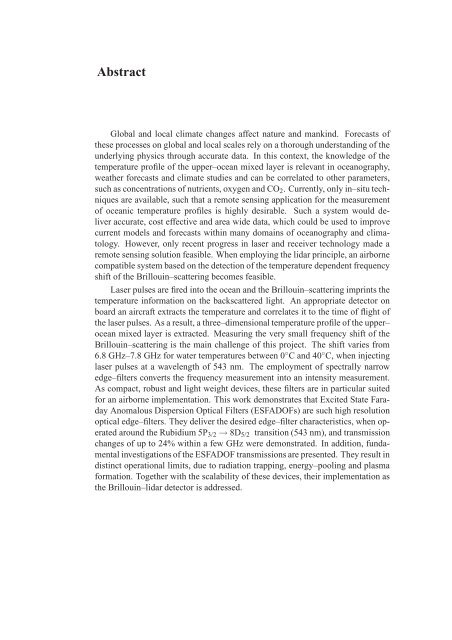Assessment of a Rubidium ESFADOF Edge-Filter as ... - tuprints
Assessment of a Rubidium ESFADOF Edge-Filter as ... - tuprints
Assessment of a Rubidium ESFADOF Edge-Filter as ... - tuprints
Create successful ePaper yourself
Turn your PDF publications into a flip-book with our unique Google optimized e-Paper software.
Abstract<br />
Global and local climate changes affect nature and mankind. Forec<strong>as</strong>ts <strong>of</strong><br />
these processes on global and local scales rely on a thorough understanding <strong>of</strong> the<br />
underlying physics through accurate data. In this context, the knowledge <strong>of</strong> the<br />
temperature pr<strong>of</strong>ile <strong>of</strong> the upper–ocean mixed layer is relevant in oceanography,<br />
weather forec<strong>as</strong>ts and climate studies and can be correlated to other parameters,<br />
such <strong>as</strong> concentrations <strong>of</strong> nutrients, oxygen and CO 2 . Currently, only in–situ techniques<br />
are available, such that a remote sensing application for the me<strong>as</strong>urement<br />
<strong>of</strong> oceanic temperature pr<strong>of</strong>iles is highly desirable. Such a system would deliver<br />
accurate, cost effective and area wide data, which could be used to improve<br />
current models and forec<strong>as</strong>ts within many domains <strong>of</strong> oceanography and climatology.<br />
However, only recent progress in l<strong>as</strong>er and receiver technology made a<br />
remote sensing solution fe<strong>as</strong>ible. When employing the lidar principle, an airborne<br />
compatible system b<strong>as</strong>ed on the detection <strong>of</strong> the temperature dependent frequency<br />
shift <strong>of</strong> the Brillouin–scattering becomes fe<strong>as</strong>ible.<br />
L<strong>as</strong>er pulses are fired into the ocean and the Brillouin–scattering imprints the<br />
temperature information on the backscattered light. An appropriate detector on<br />
board an aircraft extracts the temperature and correlates it to the time <strong>of</strong> flight <strong>of</strong><br />
the l<strong>as</strong>er pulses. As a result, a three–dimensional temperature pr<strong>of</strong>ile <strong>of</strong> the upper–<br />
ocean mixed layer is extracted. Me<strong>as</strong>uring the very small frequency shift <strong>of</strong> the<br />
Brillouin–scattering is the main challenge <strong>of</strong> this project. The shift varies from<br />
6.8 GHz–7.8 GHz for water temperatures between 0 ◦ C and 40 ◦ C, when injecting<br />
l<strong>as</strong>er pulses at a wavelength <strong>of</strong> 543 nm. The employment <strong>of</strong> spectrally narrow<br />
edge–filters converts the frequency me<strong>as</strong>urement into an intensity me<strong>as</strong>urement.<br />
As compact, robust and light weight devices, these filters are in particular suited<br />
for an airborne implementation. This work demonstrates that Excited State Faraday<br />
Anomalous Dispersion Optical <strong>Filter</strong>s (<strong>ESFADOF</strong>s) are such high resolution<br />
optical edge–filters. They deliver the desired edge–filter characteristics, when operated<br />
around the <strong>Rubidium</strong> 5P 3/2 → 8D 5/2 transition (543 nm), and transmission<br />
changes <strong>of</strong> up to 24% within a few GHz were demonstrated. In addition, fundamental<br />
investigations <strong>of</strong> the <strong>ESFADOF</strong> transmissions are presented. They result in<br />
distinct operational limits, due to radiation trapping, energy–pooling and pl<strong>as</strong>ma<br />
formation. Together with the scalability <strong>of</strong> these devices, their implementation <strong>as</strong><br />
the Brillouin–lidar detector is addressed.
















